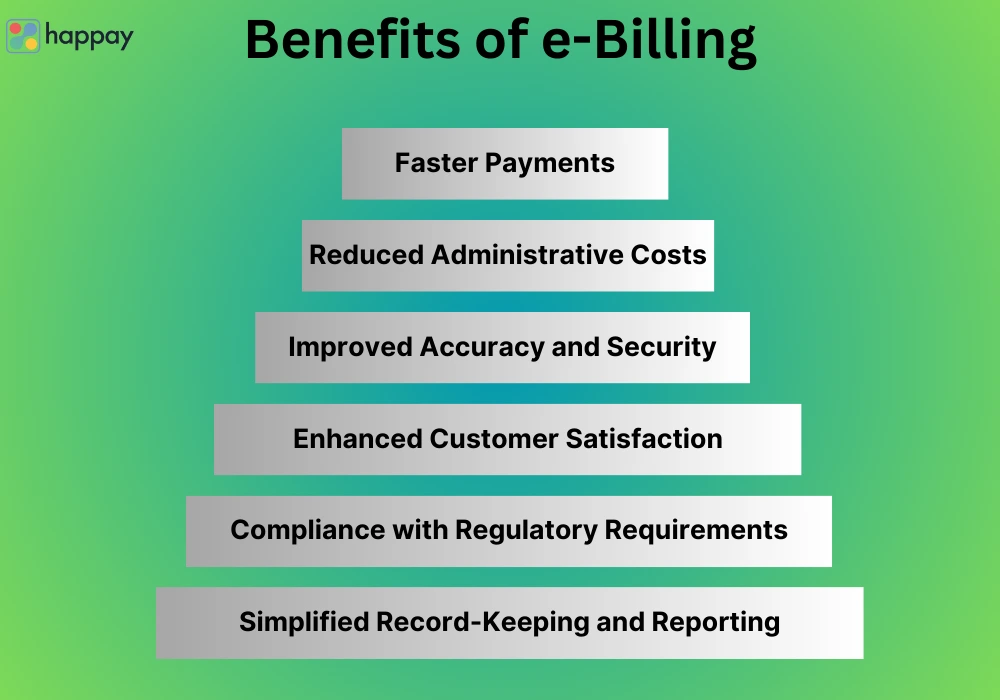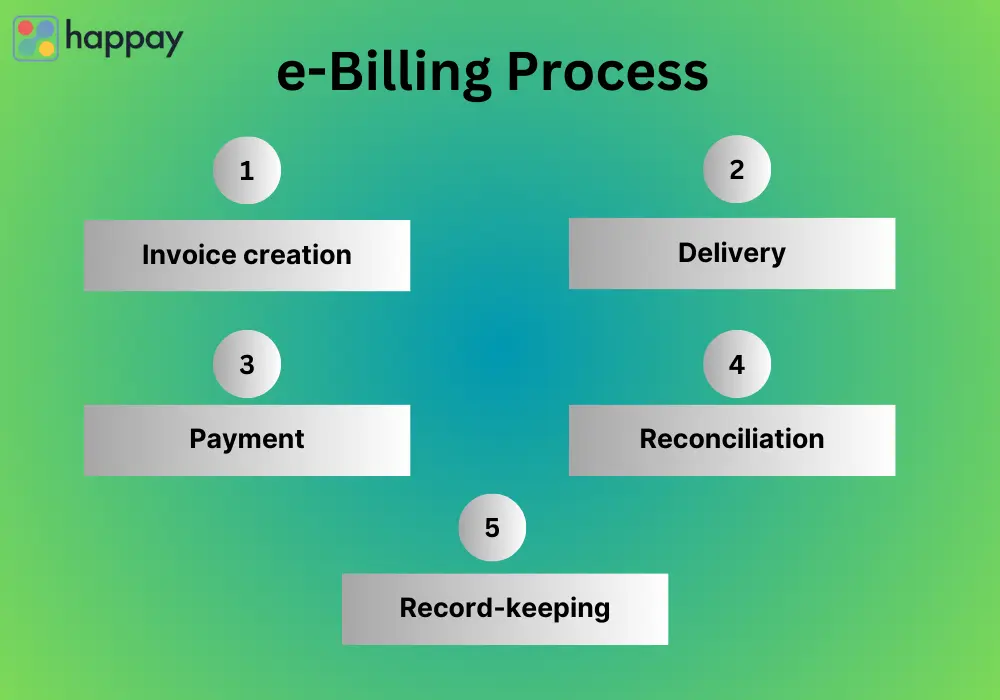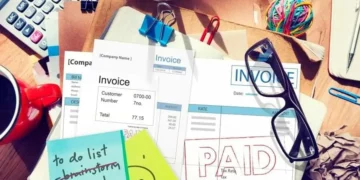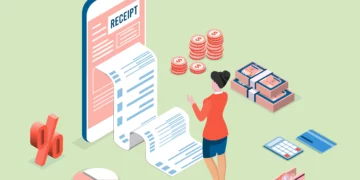Last Updated on November 28, 2025
What is e-billing?
E-billing, or electronic billing, is the process of generating and delivering invoices to customers electronically, rather than in a physical paper format. E-billing systems can automate many aspects of the billing process, from generating invoices to sending payment reminders, and can provide a more streamlined and efficient billing experience for both the company and the customer. E-billing is becoming increasingly popular due to its convenience, cost-effectiveness, and environmental benefits.
Quick Read: What is Billing, Types, Process, How it Works & Format
What is e-Bill?
An e-Bill, or electronic bill, is a digital version of a paper bill that is sent to customers through electronic means, such as email or a secure online portal. It includes all the information that a traditional paper bill would have, such as the amount due, due date, and itemized charges, but in a more convenient and environmentally-friendly format. Customers can view, download, and pay their e-Bills online, making the payment process faster and more streamlined.
What is an e-Billing system?
The e-Billing system, also known as electronic billing, is a paperless method of billing that uses electronic means to generate, deliver, and receive invoices and payments. It involves the use of technology such as email, online portals, and electronic payment systems to streamline the billing process and reduce paper waste. E-Billing is becoming increasingly popular among businesses due to its convenience, cost-effectiveness, and environmental benefits.
Importance of e-Billing for businesses
E-billing, or electronic billing, offers a range of benefits for businesses, including cost savings, improved efficiency, and enhanced customer experience. By reducing the reliance on paper-based billing systems, e-billing can help companies save money on printing and postage costs. It also simplifies the billing process, enabling businesses to send invoices and receive payments quickly and easily.
Moreover, e-billing enhances the customer experience by providing more convenient payment options and reducing the likelihood of errors or delays. Customers can receive and pay invoices electronically, reducing the need for manual data entry and eliminating the risk of lost or misplaced paper invoices. Overall, e-billing can help businesses streamline their billing process, reduce costs, and improve customer satisfaction.
Understanding electronic billing system
An electronic billing system (also known as e-billing) is a paperless method of invoicing and paying for goods and services. It involves the use of electronic media, such as email and online portals, to send and receive bills, and to complete transactions. This system eliminates the need for paper-based bills, checks, and invoices, making the process more efficient, secure, and environmentally friendly.
Electronic billing systems typically include features such as electronic payment processing, automated billing and invoicing, customizable templates for bills and invoices, and real-time tracking of transactions. These systems can be customized to meet the specific needs of businesses, and can be integrated with accounting and financial software to simplify record-keeping and reporting.
The adoption of electronic billing systems has become increasingly popular in recent years, as more businesses seek to streamline their billing processes and reduce costs associated with paper-based invoicing. The benefits of e-billing include faster payments, reduced administrative costs, improved accuracy and security, and enhanced customer satisfaction. Additionally, the use of electronic billing systems can help businesses to comply with regulatory requirements and maintain audit trails.
Quick Read: What is an Invoice: Meaning, Purpose, Types, Elements & Format
What are the benefits of e-Billing?
Electronic billing or e-Billing has gained significant popularity in recent years as businesses strive to streamline their billing processes and reduce costs. In this paperless method of invoicing and payment, electronic media, such as email and online portals, are used to send and receive bills, eliminating the need for paper-based invoices, checks, and bills.
This process offers numerous benefits to businesses, including:

- Faster Payments: With e-billing, bills can be delivered instantly, and payments can be made within seconds, reducing the time and effort required for traditional billing processes.
- Reduced Administrative Costs: The automation of billing and invoicing processes with e-billing eliminates the need for manual entry and reduces the associated administrative costs.
- Improved Accuracy and Security: E-billing ensures that there are no errors in invoices and reduces the risk of fraudulent activities. It provides secure access to payment information and eliminates the need for sensitive payment information to be transmitted through the mail.
- Enhanced Customer Satisfaction: Electronic billing allows customers to receive and pay bills conveniently, without the need for paper-based processes, leading to increased satisfaction and loyalty.
- Compliance with Regulatory Requirements: E-billing helps businesses to comply with regulatory requirements, such as retaining records of billing and payment information, and maintain audit trails.
- Simplified Record-Keeping and Reporting: Electronic billing systems can be integrated with accounting and financial software, allowing for simplified record-keeping and reporting.
In conclusion, it offers several benefits to businesses, from reducing administrative costs and improving accuracy and security to enhancing customer satisfaction and simplifying record-keeping and reporting. By adopting e-billing systems, businesses can streamline their processes, reduce costs, and achieve greater efficiency.
Quick Read: What is Invoice Management: Types, Process, Systems, Challenges
What are the types of e-Billing?
Electronic billing, or e-billing, is a paperless method of invoicing and paying for goods and services that uses electronic media such as email and online portals. There are several types of electronic billing systems available to businesses, each with unique features and benefits. In this section, we will explore the most common types of e-billing and how they work:
1. Email billing
Email billing is the most basic form of e-billing. It involves sending invoices and bills to customers via email, which they can then pay using a secure online payment portal or by mailing a physical check. This method is simple and cost-effective, but lacks many of the advanced features of other electronic billing systems.
2. Online billing portal
An online billing portal is a web-based platform that allows customers to view and pay their bills online. This type of e-billing system typically includes features such as automatic payment processing, customizable templates for bills and invoices, and real-time tracking of transactions. Online billing portals are often integrated with accounting and financial software to simplify record-keeping and reporting.
3. Mobile billing
Mobile billing allows customers to view and pay their bills using a mobile device such as a smartphone or tablet. This method is particularly useful for businesses that have a large number of customers who are frequently on the go. Mobile billing systems often include features such as push notifications and mobile payment processing to make the process even more convenient.
4. Electronic data interchange (EDI)
Electronic data interchange, or EDI, is a more complex e-billing system that involves the direct exchange of data between businesses. With EDI, businesses can send invoices and purchase orders electronically, eliminating the need for paper-based transactions. This system is particularly useful for businesses that have large volumes of transactions or need to integrate with other electronic systems.
Quick Read: 7 Types of Invoices for Your Business with Format
e-Billing for different industries
- Billing is a versatile system that can be used by businesses in different industries.
- Retail and eCommerce businesses can use e-billing to send invoices and process payments quickly and securely.
- Healthcare providers can use e-billing to streamline their billing processes and improve patient experience.
- Utility companies can use e-billing to send electronic bills and provide real-time updates on usage and charges.
- Government agencies can use e-billing to improve efficiency and transparency in financial transactions.
- Professional services firms such as law firms and accounting firms can use it to simplify invoicing and record-keeping processes.
- Nonprofit organizations can use this to reduce administrative costs and improve transparency in financial transactions.
E-billing process
1. Invoice creation
The invoice creation process may involve the use of templates or customized designs to ensure consistency and accuracy across all invoices. The invoice may also include additional information such as taxes, discounts, and payment terms. Automated invoice creation systems can save time and reduce errors by generating invoices based on predefined criteria or data pulled from other systems.
2. Delivery
Electronic delivery of invoices offers several benefits over traditional paper-based methods, such as faster delivery times, reduced costs, and increased security. Online portals may also offer features such as automatic email notifications and the ability to view previous invoices and payment history. Mobile delivery methods can provide added convenience and accessibility for customers who are frequently on the go.
3. Payment
Online payment portals are often integrated with popular payment processing systems, such as PayPal or credit card companies, allowing for secure and efficient payment processing. Automated payment processing systems can also provide additional features such as automatic payment reminders and recurring payments, further streamlining the payment process.
4. Reconciliation
The reconciliation process involves matching the payment received with the corresponding invoice and ensuring that the payment amount matches the amount due. Any discrepancies or issues are then resolved through communication between the business and the customer. Automated reconciliation systems can help to reduce errors and save time by matching payments with invoices automatically.
5. Record-keeping
Electronic record-keeping systems can simplify the process of tracking and reporting billing and payment data. Integration with accounting and financial software can provide additional benefits such as automated reporting and analysis. Accurate and easily accessible record-keeping can also help to ensure compliance with regulatory requirements and support business decisions.
In summary, the e-billing process offers numerous advantages over traditional billing methods, including speed, convenience, security, and cost-effectiveness. By implementing an e-billing system, businesses can streamline their billing processes and improve their overall efficiency, resulting in increased customer satisfaction and improved financial performance.

Quick Read: 5 Simple Ways to Improve Invoice Processing
E-Billing examples
Electronic billing, or e-billing, has become increasingly popular in recent years, and there are now many examples of businesses and industries that are using this technology to streamline their billing processes.
Here are a few examples:
- Online retailers like Amazon and eBay use e-billing to send invoices and process payments for millions of transactions each day. Compared to traditional paper-based invoicing, e-billing allows these companies to save time, reduce costs, and improve accuracy.
- Utility companies like water, gas, and electricity providers use e-billing to send bills and track payments from their customers. With e-billing, these companies can save on printing and mailing costs while providing a more convenient and eco-friendly billing option for their customers.
- Subscription-based businesses like Netflix and Spotify use e-billing to manage recurring payments from their customers. E-billing makes it easy for these companies to automatically charge their customers on a regular basis, ensuring that they receive consistent revenue without the need for manual invoicing.
- Healthcare providers like hospitals and clinics use e-billing to send invoices and track payments from patients and insurance companies. Compared to paper-based billing, e-billing allows healthcare providers to streamline their revenue cycle management and reduce the risk of errors and delays.
In summary, it has become a critical tool for businesses across a range of industries, offering a more efficient, cost-effective, and environmentally friendly way to bill and receive payments. It’s like the difference between sending a message via carrier pigeon versus using a high-speed internet connection – e-billing is faster, more reliable, and way less messy!
Best practices for e-Billing
1. Keep it simple
One of the most important best practices for e-billing is to keep the process as simple and user-friendly as possible. This means using clear and concise language, providing easy-to-understand instructions, and avoiding unnecessary steps or complications. By streamlining the e-billing process, businesses can reduce customer frustration and increase the likelihood of timely payments.
2. Provide multiple payment options
Another best practice is to offer customers multiple payment options, such as credit cards, e-checks, and mobile payments. This can help increase convenience and reduce the likelihood of payment delays or disputes. By providing a variety of payment options, businesses can cater to different customer preferences and increase overall satisfaction.
3. Ensure security
It’s essential to prioritize the security of customer information and financial data when implementing an e-billing system. This includes using secure payment portals, encrypting sensitive data, and regularly monitoring for potential security breaches or fraud. By taking proactive measures to ensure security, businesses can protect customer data and prevent potential legal and financial issues.
4. Optimize for mobile
As more customers use mobile devices to access their bills and make payments, it’s important to ensure that e-billing systems are optimized for mobile use. This can include using responsive design, providing mobile-friendly payment options, and simplifying the overall process. By prioritizing mobile optimization, businesses can improve customer experience and increase the likelihood of timely payments.
5. Provide clear and timely communication
Finally, it’s essential to provide clear and timely communication throughout the e-billing process. This includes sending regular reminders about upcoming payments, providing updates on payment status, and addressing any customer concerns or issues in a timely and professional manner. By communicating effectively with customers, businesses can build trust, reduce the likelihood of disputes, and ultimately increase customer satisfaction.
By following these best practices, businesses can create a seamless and efficient e-billing process that benefits both customers and the organization itself.
What are some of the common e-Billing challenges?
As with any technology implementation, there are certain challenges that businesses may face when implementing an e-billing system.
Some of the common e-billing challenges include:
- Customer adoption: Encouraging customers to adopt a new billing process can be a challenge, particularly if they are used to receiving paper bills.
- Data accuracy: Ensuring the accuracy of customer information and financial data is crucial for the success of an e-billing system. Any errors or discrepancies can lead to delays in payment processing or disputes.
- Payment processing: While electronic payment methods are typically faster and more efficient than traditional payment methods, businesses may still encounter issues with payment processing, such as failed transactions or payment disputes.
- Security: Protecting customer data and financial information is a top priority for businesses implementing e-billing systems. Ensuring the security of these systems can be a complex and ongoing challenge.
- Regulatory compliance: Depending on the industry and location, there may be specific regulations that businesses must comply with when implementing e-billing systems, such as data privacy laws or payment processing regulations.
By being aware of these challenges and taking steps to address them proactively, businesses can successfully implement e-billing systems and enjoy the benefits of a more efficient and streamlined billing process
What is e-invoicing?
E-invoicing refers to the electronic exchange of invoices between businesses and their customers or suppliers. Rather than sending and receiving paper invoices through traditional mail, e-invoicing involves the use of digital technologies such as email, online portals, and other electronic mediums to generate, send, and receive invoices. E-invoicing can provide several benefits, including faster processing times, reduced costs, and improved accuracy and efficiency in billing and payment processes.
What is the difference between e-invoicing and e-billing?
Overall, while e-invoicing is a more specific process that focuses on the structured exchange of invoices between systems, e-billing is a broader term that encompasses the entire process of generating and sending invoices electronically.
|
Feature |
E-invoicing |
E-billing |
|
Process |
A structured process for the creation and exchange of invoices through a centralized platform. |
A broad term that refers to the process of generating and sending invoices using electronic methods. |
|
Purpose |
To facilitate the direct transmission of invoices from one system to another, automating the invoicing process. |
To enable businesses to generate invoices and send them to customers electronically, increasing efficiency and reducing costs. |
|
Interoperability |
Uses standardized formats and communication protocols for the exchange of invoices between different systems. |
May use different file formats and communication protocols, depending on the organization’s specific e-billing system. |
|
Regulatory compliance |
E-invoicing may be required by some governments to comply with tax and other regulations. |
E-billing may not be mandated by regulatory bodies, but can still provide benefits to businesses that choose to adopt it. |
Quick Read: Difference Between Invoice and Bill: A Complete Guide
What is an e-billing software?
An e-billing software is a digital tool that streamlines the billing process by automating the creation, delivery, and payment of invoices. It allows businesses to send invoices electronically to customers and receive payments quickly and securely. E-billing software can also provide real-time updates and analytics to help businesses track their billing activity.
TOP 5 e-billing software
Here are five popular e-billing software options:
- FreshBooks: A cloud-based software that offers time tracking, invoicing, and payment processing capabilities. It also provides detailed financial reports and integrates with other accounting software.
- Zoho Invoice: A user-friendly software that allows businesses to create and send customized invoices, receive payments online, and track expenses. It also offers mobile apps for iOS and Android.
- QuickBooks: A well-known accounting software that offers e-billing capabilities as part of its invoicing feature. It allows businesses to automate payment reminders and offers payment processing options.
- Xero: A cloud-based accounting software that offers invoicing, payment processing, and expense tracking capabilities. It also provides detailed financial reports and integrates with other business software.
- Wave: A free accounting software that offers invoicing, payment processing, and receipt scanning capabilities. It also provides access to detailed financial reports and integrates with other business tools.
Quick Read: 11 Best Billing Software for Businesses
Why should you automate your e-Billing system with e-Billing software?
Automating your e-billing system with e-billing software can provide numerous benefits, such as improved efficiency, cost savings, and increased accuracy. With e-billing software, businesses can streamline the entire billing process, from invoice creation to payment reconciliation and record-keeping.
E-billing software can automate many time-consuming tasks, such as sending invoices, processing payments, and generating reports. It can also reduce errors and delays by automating workflows and providing real-time data on payment status and transaction history.
Overall, e-billing software can help businesses save time, reduce costs, and improve accuracy and efficiency in their billing processes.
FAQs
The objective of e-billing is to provide a more efficient, cost-effective, and environmentally friendly way for businesses to bill and receive payments from customers, while also streamlining the billing process and improving customer satisfaction.
The main purpose of billing is to generate invoices or bills that detail the products or services provided to a customer and the amount due for payment. It helps to facilitate the collection of payments from customers and keep track of financial transactions.
The common types of e-billing include email, web-based portals, mobile applications, and electronic data interchange (EDI).
There are several benefits of e-billing to customers, including:
1. Convenience: E-billing allows customers to receive and pay bills from anywhere with an internet connection, at any time of day or night.
2. Time-saving: With e-billing, customers can quickly view and pay bills online, without the need to visit a physical location or wait for a paper bill to arrive in the mail.
3. Environmentally friendly: E-billing reduces paper waste, which is beneficial for the environment.
4. Increased security: E-billing systems often provide secure payment portals and encryption to protect customer information and financial data.
Cost-effective: E-billing eliminates the need for printing and mailing paper bills, which can save customers money on postage and other fees.
Billing helps businesses to receive payments from customers and maintain accurate financial records.










Discussion about this post